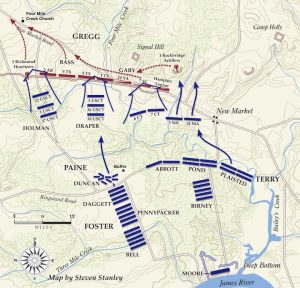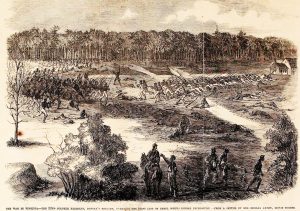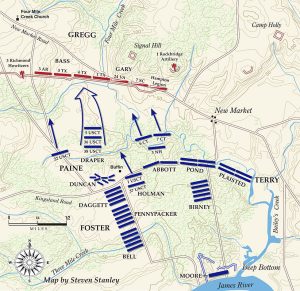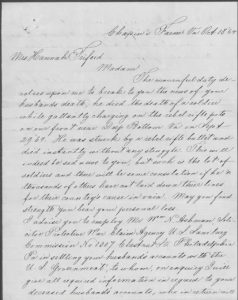Fallen but not Forgotten: Corporal Obadiah Triford, Co. G, 22nd USCI

Recently the Capital Region Land Conservancy announced the addition of 49 acres to the growing total saved at the New Market Heights battlefield. This particular section of the battlefield, located on the Federal left during the September 29, 1864 assaults, is where Col. John Holman’s brigade (22nd, 1st, and 37th United States Colored Infantry regiments) attacked. It contains a section of well-preserved earthworks defended by the 3rd Arkansas (Texas Brigade) and also covered by the adjacent 3rd Richmond Howitzers. It was probably on this part of the battlefield that Corp. Obadiah Triford (sometimes spelled Treford and Tryford) fell killed in action battling to abolish slavery, demand citizenship, and obtain the rights the Constitution grants.

The historical record is limited on information about Corp. Triford’s life before his enlistment. His Compiled Military Service Record (CMSR) tells us that he was born in Virginia, about 1839. The first public record for Triford appears to be from the 1850 United States census. Listed as residing in Moyamensing Ward 2 in South Philadelphia with his father William Tryford, a seaman, his mother Sarah, and brothers Andrew and William, Obediah was the middle child.
The 1850 census lists all members of the family as being born in Pennsylvania. However, since Obadiah stated at his enlistment that he was born in Virginia, the information they provided on the census may have been their effort to cover their tracks if they had fled enslavement in the Old Dominion and relocated to Philadelphia. At the time of their census recording the revised and strengthened Fugitive Slave Law was a hotly debated topic. Congress passed it making it a federal law about a month after Obadiah’s family provided their information to the census taker.
Obadiah nor his family appeared in a search of the 1860 census, but a few years before that census he experienced a life changing event. He became a father. After learning of Obadiah’s death at New Market Heights, Hannah Hopkins Triford, detailed in her pension application that she and Obadiah had a daughter named Anna Louisa (also called Julia A. in some records), who was born on January 28, 1857. The information in Hannah’s pension application file also states that she and Obadiah lived together for about seven years before he enlisted, which coincides with the time their daughter was born.
Enlisting on January 10, 1864, in Waterford, Camden County, New Jersey, Obadiah stated he was 25 years old. A little under average height at five feet three inches, with a black complexion, and “curly” hair, the former laborer officially became a United States soldier when he formally mustered into the 22nd United States Colored Infantry at Camp William Penn in Philadelphia. But less than a month later, on February 6, he deserted.
It is speculation to guess what truly happened, but records give a clue as to what may have occurred to prompt Obadiah’s desertion. In Hannah’s pension file there is a signed affidavit from Rev. Joshua Eddy of the Bethel Church on Sixth Street in Philadelphia stating that he married Obadiah and Hannah on February 7, 1864, the day after Obadiah deserted. Did Obadiah seek formal permission from his officers and receive rejection? Did he fear punishment for taking leave without approval and thus not immediately return? Did Obadiah feel a pressing need to formalize his common law relationship with Hannah in case he was killed or died of disease while in the army? Marriage would provide benefits for his wife and young daughter should something happen. We simply do not know his true motivation for deserting.
Obadiah’s CMSR states that he was apprehended on February 15, 1864, in Harrisburg. His regiment transferred to Virginia around the same time. Whatever the true situation, Obadiah apparently resolved it to his officers’ satisfaction because records indicate that they reinstated him without trial or loss of pay, however, he was charged $32.95 for transportation, presumably to catch up with the regiment then posted in Virginia. He was also charged $23.36 for losing “ordnance stores,” and $2.81 for camp and garrison equipment. Obadiah rejoined the 22nd USCI at Fort Magruder, near Yorktown, Virginia, on March 8, 1864, and was reinstated to the company muster rolls by verbal order from regimental headquarters on April 19.

As part of the newly formed Army of the James, the 22nd USCI was one of several Black regiments that moved up the James River toward Petersburg in early May. On June 15, 1864, they received their first real taste of battle at Baylor’s Farm breaking the Confederate defenses there and capturing an artillery piece. Later in the day they assaulted the Dimmock Line at Petersburg taking several Confederate fortified positions. The 22nd lost 14 killed, 116 wounded, and 8 missing during the day’s fighting. Col. Joseph Kiddoo noted in his official report that, “During the whole day my regiment, both officers and men, behaved in such a manner as to give me great satisfaction and the fullest confidence in the fighting qualities of colored troops.” One wonders if Pvt. Triford distinguished himself in some way during these actions, as he received promotion to corporal on July 1, 1864.
The 22nd USCI spent the remaining summer months serving on the north side of the Appomattox River and in the Petersburg trenches east of the city. Confederates took particular pleasure in harassing the Black soldiers when they appeared across the lines from the Southerners. Enduring artillery shelling and rifle sniping became an almost daily challenge. On September 28, the 22nd, 1st, and 37th USCI regiments consolidated at Deep Bottom forming the First Brigade, Third Division, XVIII Corps, in order to participate in the following day’s offensive.
Early on the morning of September 29, 1864, the three brigades of the Third Division, XVIII Corps, moved from their camp at Deep Bottom Landing toward the Confederate position that paralleled New Market Road. According to the official report made by Capt. Albert James, the 22nd USCI positioned itself at the head of the brigade column in the center rear of the two other Third Division brigades. They were likely just south of the Buffin house and Kingsland Road. After witnessing the repulse of the Third Brigade’s (Col. Duncan’s 4th and 6th USCIs) initial assault, Capt. James noted that his regiment “deployed as skirmishers and moved forward under a heavy fire of artillery from the right [Rockbridge Artillery], which nearly enfiladed the line. One officer and eight men were wounded by shells from this source.”
While skirmishing on the left of the Second Brigade’s (Col. Draper’s 5th, 36th, and 38th USCIs) attack column, the 22nd USCI negotiated a “dense tangle of underbrush and felled trees” and emerged into cleared area. “Here the first line of the enemy’s pickets was encountered, who were stationed across the plain in a piece of woods,” Capt. James explained. Several of the men fell as casualties at this time, but the Confederate main defensive line was still ahead with “an abatis in front.” Then, “As the charging column came up to the support of the skirmish line a part of the regiment assembled . . . and moved forward into the works, driving the enemy in confusion from them.”

The official records do not note where and when in the battle Corp. Triford fell. However, a condolence letter sent to Hannah by Company G’s Capt. Charles F. Eichacker gives some details of Obadiah’s battlefield death. Written on October 18, 1864, Eichacker penned: “The mournful duty devolves upon me to break to you the news of your husbands death; he died the death of a soldier while gallantly charging on the rebel rifle pits on our front near Deep Bottom Va on Sept. 29 ’64. He was struck by a rebel ball and died instantly without struggle. This will be indeed sad news to you, but such is the lot of soldiers and there will be some consolation if he & thousands of others have not laid down their lives for their country’s cause in vain. May you find strength [to] bear your personal loss.”

Capt. Eichacker went on to advise Hannah to contact an individual he recommended in Philadelphia to help her navigate the pension claims system. Eichacker also left a postscript: “Enclosed please find your letter to your deceased husband, I was under the necessity of opening it to ascertain the whereabouts of his relatives.” A copy of Hannah’s letter to Obadiah that Eichacker returned to her is not included among the pension papers.

At New Market Heights the 22nd USCI had six men killed, five fatally wounded, and 34 wounded who survived. Obadiah’s Company G suffered the majority of the casualties in the regiment with one killed (Corp. Triford), one fatally wounded, and 12 wounded who survived.
Unfortunately, as is the case with so many other aspects of Corp. Triford’s brief life, his final resting place is unknown. However, his service to his country and willingness to sacrifice of his life while fighting for the founding principles of the United States is certainly worthy of remembrance and honor.
Sources:
1850 U.S. Census, accessed via Ancestry.com
Civil War “Widows” Pensions for Corp. Obadiah Triford, Co. G, 22nd USCI, accessed via Fold3.com
Complied Military Service Record for Corp. Obadiah Triford, Co. G, 22nd USCI, accessed via Fold3.com
Manarin, Louis H. Henrico County, Field of Honor, Vol. II. Henrico County, 2004.
O.R. Vol. 40, Part 1
O.R. Vol. 42, Part 1
Price, James S. The Battle of New Market Heights: Freedom Will Be Theirs by the Sword. History Press, 2011.
The mission of the Battle of New Market Heights Memorial and Education Association is to commemorate and educate. We seek to erect a monument at the site of the Battle of New Market Heights honoring the United States Colored Troops who served in the Third Division of the XVIII Corps (Army of the James). Among these men were fourteen African American soldiers and two white officers who received the Medal of Honor for acts of heroism on September 29, 1864. We also seek to educate the public about this significant military victory by the United States Colored Troops. More information is available at https://battleofnewmarketheights.org. As part of a collaboration between ECW and BNMHMEA, this piece is cross-posted at their website.
“The 22nd lost 14 killed, 116 wounded, and 8 missing during the day’s fighting.” Be interested to know how many of the 22nd were engaged. Sounds like some fearsome fighting.
I congratulate the author on the research of a wonderful personal interest story and the use of the two Steven Stanley maps of the attacks on the Dimmock Line.
Yes, the 22nd USCI certainly did tough work on June 15, 1864. Will Greene’s “Campaign of Giants” does and excellent job of describing the fighting done by Hinks’ USCT division that day.
Thank you for the kind words about my research. Finding information about these men who paid the ultimate sacrifice at the Battle of New Market Heights is such a rewarding experience. The Steven Stanley maps actually depict a couple of the phases of fighting at New Market Heights (Sept. 29, 1864).